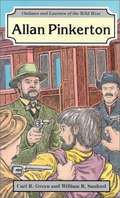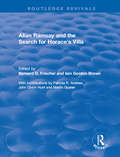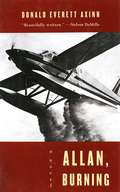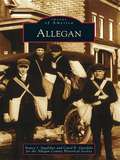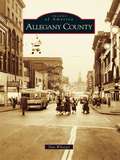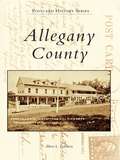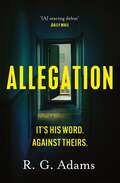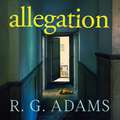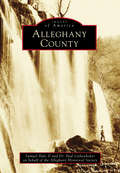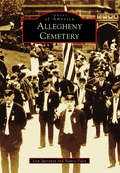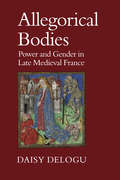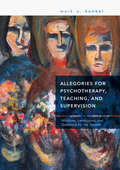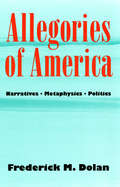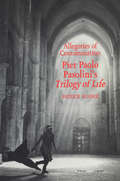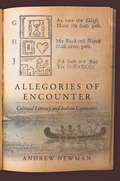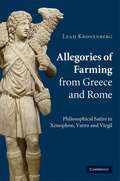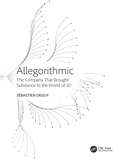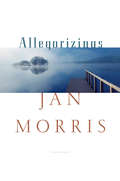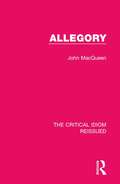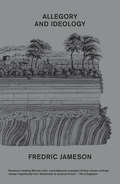- Table View
- List View
Allan Pinkerton (Outlaws and Lawmen of the Wild West)
by Carl R. Green William R. SanfordBiographies of famous and infamous men of the Western frontier. - Entices the reluctant reader to relive the exciting days of the Wild West.
Allan Ramsay and the Search for Horace's Villa (Routledge Revivals)
by Ian Gordon BrownThis title was first published in 2001. This volume contains Allan Ramsay's "Enquiry into the Situation and Circumstances of Horace's Sabine Villa". It also features essays about Ramsay, Jacob More, Jacob Philipp Hackert, the garden and country house in 18th-century British thought, and the archaeology of the Licenza Valley. The aims of the editors are three-fold: to print the text as Ramsay would have wished to, had he been able; to publish the related illustrations by Hackert, More and Ramsay; and to provide some basic background facts and commentary. They hope to help the contemporary reader understand the antiquarian context in which Ramsay was writing and to appreciate Ramsay's contribution to our understanding of the site conventionally known as Horace's Villa.
Allan, Burning: A Novel
by Donald Everett AxinnHappily married with two beautiful children, successful architect and avid amateur aviator Allan Daniels finds his life plummeting into a nightmare when his wife suddenly announces that she wants a separation, maybe a divorce. Then, two days later, as he is piloting a seaplane from Long Island to Key West, the engine of his Cessna 185 seaplane sputters, then quits. Daniels's resolute skills as a pilot enable him to land safely in the Everglades, where a disheveled Miccosukee man named Tommy Handley finds him. But while Handley turns out to be from the same tribe as Daniels's mother, he also turns out to be a fugitive from justice, hiding out and evading capture in the protection of the remote swamps. When Daniels wakes in the middle of the night to find Handley groping for his wallet, Daniels defends himself--but accidentally kills his rescuer, then flees in his boat, from which locals later rescue him again. Daniels's explanation of what happened in the swamp doesn't sit well with savvy local lawman Sheriff Haskins, who suspects that Daniels is hiding something--but what? When Daniels finally confesses his guilt, it will set off a whole new chain of dire events in this fast-paced novel with enough twists and turns to keep you guessing until the final page.
Allbirds: Decarbonizing Fashion
by Michael W. Toffel Eren Kuzucu Ken PuckerAllbirds is a footwear startup focused on simple design, comfort, and sustainable natural materials. The case describes the company's product development process that works with suppliers to develop natural materials including wool and sugarcane to substitute for conventional petroleum-based materials and leather. The case is set in 2021, when Allbirds was extending its product range into apparel, and expanding beyond its online store to open more retail store around the world. Allbirds was freely sharing its know-how and material innovations with its competitors to try to scale its efforts to decarbonize fashion, but was also keen to remain ahead and differentiated based on simple design, comfort, and sustainable natural materials. The case highlights the growing the environmental impact of the footwear industry, including from its use of leather and fossil-fuel-based materials, and its focus on shorter product lifespans.
Allegan (Images of America)
by Carol Garofalo Allegan County Historical Society Nancy J. IngalsbeeDuring the summer of 1834, a group of eastern land investors set its sights on newly platted land at the "great bend" in the Kalamazoo River, now known as Allegan. This former site of a Pottawatomi village was blessed with both beauty and bounty. Surrounded by woods and with a river racing throughit, a busy community of commerce and recreation was envisioned. It was a perfect combination for enjoyable and productive lives for those who would purchase parcels of land. They could never imagine the many changes their riverside village would see--the part it would play in the rebuilding of Chicago after the Great Fire of 1871; Allegan's own devastating fire in 1884, which destroyed the downtown area; the arrival and departure of various businesses; and the phenomenon of countless local families who have had a continuous presence in Allegan for many generations. It is the stories behind these photographs of people, businesses, and events that bring Allegan's past to light in such a marvelous way.
Allegany County
by Dan WhetzelAllegany County's historical significance covers a broad range of topics and years. Established in 1789, the county rapidly developed in the 19th century due to transportation advantages, industrialization, natural resources, and the entrepreneurial spirit of its citizens. Allegany County's economy continued to expand in the 20th century, as additional industries made western Maryland their home. Industrial growth created towns and commercial opportunities that have shaped the county's character for more than two centuries.
Allegany County (Postcard History Series)
by Albert L. FeldsteinAllegany County was established in 1789 and is truly one of America's historic transportation and industrial centers. The images presented here portray this heritage and were selected with care from the author's collection of several thousand postcards. The book features Allegany's towns and communities, downtown business scenes, residential areas, industries, historic buildings, churches, schools, hospitals, floods, parades, coal mining, railroad stations, and historic and natural landmarks. In some cases, the personal messages sent on the back of the postcards are included.
Allegation: the page-turning, unputdownable thriller from an exciting new voice in crime fiction
by R. G. Adams'This searing debut from a retired social worker of 30 years could not be more timely - nor more true ... Harrowing, moving and written with a fearsome authenticity, the story forces the reader to question where the truth lies' Daily MailAn evil monster exposed? Or an innocent father condemned? A scandal will shake a small community to its very foundations.Two women have come forward to make historical sexual allegations against a pillar of the local community, Matthew Cooper. The case lands on the desk of inexperienced Social Worker, Kit Goddard, who must remove Cooper from his home and family while the investigation is carried out. Although intrepid and intuitive, she is ill-prepared for such a high-profile case.Kit finds herself navigating a local minefield of connections and class, reputations and rumour. Unsure whether her interference is a heroic intervention or a hurtful intrusion, she knows one thing: it will have an impact. The question is whether this impact will be to expose a lie, or destroy an innocent life...
Allegation: the page-turning, unputdownable thriller from an exciting new voice in crime fiction
by R. G. AdamsThere isn't going to be an easy way to say this . . .'An evil monster exposed?'. . . I'm afraid an allegation has been made'Or an innocent father condemned?A scandal will shake a small community to its very foundations.Sandbeach, South Wales. Two women have come forward to make historical sexual allegations against a pillar of the local community, Matthew Cooper. And child-safeguarding protocol demands that Social Services remove the accused from his home and his family, while a formal assessment is carried out.The Cooper case lands on the desk of inexperienced Social Worker, Kit Goddard. Although intrepid and intuitive, she is ill-prepared for such a high-profile case.Kit finds herself navigating a local minefield of connections and class, reputations and rumour. Unsure whether her interference is a heroic intervention or a hurtful intrusion, she knows one thing: it will have an impact. The question is whether this impact will be to expose an iniquitous lie, or destroy an innocent life...(P)2020 Quercus Editions Limited
Alleghany County (Images of America)
by Alleghany Historical Society Dr Paul Linkenhoker Samuel Hale IIAlleghany County was formed in 1822 from parts of Botetourt, Bath, and Monroe Counties. The area was settled in 1746, and by the early part of the 19th century, a number of settlements and large farms were operating locally. Covington, Clifton Forge, Iron Gate, Longdale, Selma, Low Moor, and other small communities developed, and the natural resources in the area led to the establishment of several industrial operations. The railroad came to Selma in 1857, and after the Civil War, the Chesapeake & Ohio Railroad was completed to Huntington, West Virginia. The abundance of timber, rich deposits of iron ore, and accessibility to rails, rivers, and streams contributed to industrial growth. Brickyards, lumber mills, tanneries, iron smelters, and agricultural operations attracted other businesses and industries, bringing rapid growth to the area. In Covington, the West Virginia Pulp and Paper Company built a mill in 1899. Ever since, the company has served as the county's economic mainstay.
Allegheny Cemetery (Images of America)
by Lisa Speranza Nancy FoleyIt is easy to look at a place such as Allegheny Cemetery in Pittsburgh's Lawrenceville neighborhood and think that it encompasses strictly the dead. But a closer look reveals many lives and stories told throughout the pages of time by those who have lived them. To define Allegheny Cemetery as simply a place does not do it justice. It is not only a physical location, but a crossroads in history, and a point in time where each of these lives converge. Images of America: Allegheny Cemetery shares these legacies with the hope that present and future generations will do the same.
Allegorical Bodies
by Daisy DeloguAllegorical Bodies begins with the paradoxical observation that at the same time as the royal administrators of late fourteenth and early fifteenth-century France excluded women from the royal succession through the codification of Salic law, writers of the period adopted the female form as the allegorical personification of France itself. Considering the role of female allegorical figures in the works of Eustache Deschamps, Christine de Pizan, and Alain Chartier, as well as in the sermons of Jean Gerson, Daisy Delogu reveals how female allegories of the Kingdom of France and the University of Paris were used to conceptualize, construct, and preserve structures of power during the tumultuous reign of the mad king Charles VI (1380-1422).An impressive examination of the intersection between gender, allegory, and political thought, Delogu's book highlights the importance of gender to the functioning of allegory and to the construction of late medieval French identity.
Allegorical Form and Theory in Hildegard of Bingen’s Books of Visions (The New Middle Ages)
by Dinah WoutersThis book analyses how the three books of visions by Hildegard of Bingen use the allegorical vision as a form of knowledge. It describes how the visionary’s use of allegory and allegorical exegesis is linked to theories of cognition, interpretation, and prophecy. It argues that the form of the allegorical vision is not just the product of a medieval symbolic mentality, but specific to Hildegard’s position and the major transformations taking place in the prescholastic intellectual milieu, such as the changing use of Scripture or the shift from traditional hermeneutics to cognitive language philosophy. The book shows that Hildegard uses traditional forms of knowledge – prophecy, the vision, monastic theology, allegorical hermeneutics – in startlingly innovative ways by combining them and by revising them for her own time.
Allegorical Readers and Cultural Revision in Ancient Alexandria
by David DawsonAllegorical readings of literary or religious texts always begin as counterreadings, starting with denial or negation, challenging the literal sense: "You have read the text this way, but I will read it differently." David Dawson insists that ancient allegory is best understood not simply as a way of reading texts, but as a way of using non-literal readings to reinterpret culture and society. Here he describes how some ancient pagan, Jewish, and Christian interpreters used allegory to endorse, revise, and subvert competing Christian and pagan world views.This reassessment of allegorical reading emphasizes socio-cultural contexts rather than purely formal literary features, opening with an analysis of the pagan use of etymology and allegory in the Hellenistic world and pagan opposition to both techniques. The remainder of the book presents three Hellenistic religious writers who each typify distinctive models of allegorical interpretation: the Jewish exegete Philo, the Christian Gnostic Valentinus, and the Christian Platonist Clement. The study engages issues in the fields of classics, history of Christianity and Hellenistic Judaism, literary criticism and theory, and more broadly, critical theory and cultural criticism.
Allegories for Psychotherapy, Teaching, and Supervision: Windows, Landscapes, and Questions for the Traveler
by Mark A. KunkelThis book explores the practice of psychotherapy, teaching, and supervision via allegory, metaphor, and myth. Based upon the author’s own extensive teaching and practice, Mark Kunkel takes the reader through a series of vignettes that are windows not only into reality, but also into the soul. The author's approach reflects his vocational commitment to an integration of conceptualization, affective involvement, and application. These allegories, parables, and myths serve to clarify and open important issues in teaching, psychotherapeutic, and clinical supervisory settings, and are intended to be allies in individual study and group discussion alike.
Allegories of America: Narratives, Metaphysics, Politics (Contestations)
by Frederick M. DolanAllegories of America offers a bold idea of what, in terms of political theory, it means to be American. Beginning with the question What do we want from a theory of politics? Dolan explores the metaphysics of American-ness and stops along the way to reflect on John Winthrop, the Constitution, 1950s behavioralist social science, James Merrill, and William Burroughs.The pressing problem, in Dolan's view, is how to find a vocabulary for politics in the absence of European metaphysics. American political thinkers, he suggests, might respond by approaching their own theories as allegories. The postmodern dilemma of the loss of traditional absolutes would thus assume the status of a national mythology—America's perennial identity crisis in the absence of a tradition establishing the legitimacy of its founding.After examining the mid-Atlantic sermons of John Winthrop, the spiritual founding father, Dolan reflects on the authority of the Constitution and the Federalist. He then takes on questions of representation in Cold War ideology, focusing on the language of David Easton and other liberal political "behaviorists," as well as on cold War cinema and the coverage of international affairs by American journalists. Additional discussions are inspired by Hannah Arendt's recasting of political theory in a narrative framework. here Dolan considers two starkly contrasting postwar literary figures—William S. Burroughs and James Merrill—both of whom have a troubled relationship to politics but nonetheless register an urgent need to articulate its dangers and opportunities. Alongside Merrill's unraveling of the distinction between the serious and the fictive, Dolan assesses the attempt in Arendt's On Revolution to reclaim fictional devices for political reflection.
Allegories of Contamination
by Patrick RumbleThe Trilogia della vita (Trilogy of Life) is a series of three films that Pier Paolo Pasolini completed before his horrifying assassination in 1975, and it remains among the most controversial of his cinematic works. In Allegories of Contamination Patrick Rumble provides an incisive critical and theoretical study of these films and the Marxist filmmaker's complex, original concept of the cinematic medium.With the three films that make up the Trilogy of Life - The Decameron, Canterbury Tales, and The Arabian Nights - Pasolini attempts to recapture the aura surrounding popular, predominantly oral forms of storytelling through a pro-modern vision of innocent, unalienated bodies and pleasures. In these works Pasolini appears to abandon the explicitly political engagement that marked his earlier works - films that led him to be identified with other radical filmmakers such as Bellocchio, Bertolucci, and Godard. However, Pasolini insisted that these were his 'most ideological films,' and his political engagement translates into a mannerist, anti-classical style or what he called a 'cinema of poetry.' Rumble offers a comparative study based on the concept of 'aesthetic contamination,' which is fundamental to the understanding of Pasolini's poetics. Aesthetic contamination concerns the mediation between different cultures and different historical moments. Through stylistic experimentation, the Trilogy of Life presents a genealogy of visual codes, an interrogation of the subjectivity of narrative cinema. In these films Pasolini celebrates life, and perhaps therein lies their simple heresy.
Allegories of Encounter: Colonial Literacy and Indian Captivities (Published by the Omohundro Institute of Early American History and Culture and the University of North Carolina Press)
by Andrew NewmanPresenting an innovative, interdisciplinary approach to colonial America's best-known literary genre, Andrew Newman analyzes depictions of reading, writing, and recollecting texts in Indian captivity narratives. While histories of literacy and colonialism have emphasized the experiences of Native Americans, as students in missionary schools or as parties to treacherous treaties, captivity narratives reveal what literacy meant to colonists among Indians. Colonial captives treasured the written word in order to distinguish themselves from their Native captors and to affiliate with their distant cultural communities. Their narratives suggest that Indians recognized this value, sometimes with benevolence: repeatedly, they presented colonists with books.In this way and others, Scriptures, saintly lives, and even Shakespeare were introduced into diverse experiences of colonial captivity. What other scholars have understood more simply as textual parallels, Newman argues instead may reflect lived allegories, the identification of one's own unfolding story with the stories of others. In an authoritative, wide-ranging study that encompasses the foundational New England narratives, accounts of martyrdom and cultural conversion in New France and Mohawk country in the 1600s, and narratives set in Cherokee territory and the Great Lakes region during the late eighteenth century, Newman opens up old tales to fresh, thought-provoking interpretations.
Allegories of Farming from Greece and Rome
by Leah KronenbergIn this book Professor Kronenberg shows that Xenophon's Oeconomicus, Varro's De Re Rustica and Virgil's Georgics are not simply works on farming but belong to a tradition of philosophical satire which uses allegory and irony to question the meaning of morality. These works metaphorically connect farming and its related arts to political life; but instead of presenting farming in its traditional guise as a positive symbol, they use it to model the deficiencies of the active life, which in turn is juxtaposed to a preferred contemplative way of life. Although these three texts are not usually treated together, this book convincingly connects them with an original and provocative interpretation of their allegorical use of farming. It also fills an important gap in our understanding of the literary influences on the Georgics by showing that it is shaped not just by its poetic predecessors but by philosophical dialogue.
Allegories of Neoliberalism: Contemporary South Asian Fictions, Capital, and Utopia
by Sarker Hasan ZayedSimultaneously a critique of Foucauldian governmentalist interpretations of neoliberalism and a historical materialist reading of contemporary South Asian fictions, Allegories of Neoliberalism is a probing analysis of literary representations of capitalism’s “forms of appearance.” This book offers critical discussions on the important works of Akhtaruzzaman Elias, Amitav Ghosh, Aravind Adiga, Arundhati Roy, H. M. Naqvi, Mohsin Hamid, Nasreen Jahan, Samrat Upadhyay, and other writers from South Asia and South Asian diaspora. It also advances a re-reading of Karl Marx’s Capital through the themes and tropes of literature—one that looks into literary representations of commoditization, monetization, class exploitation, uneven spatial relationship, financialization, and ecological devastation through the lens of the German revolutionary’s critique of capitalism.
Allegories of Violence: Tracing the Writings of War in Late Twentieth-Century Fiction (Literary Criticism and Cultural Theory)
by Lidia YuknavitchAllegories of Violence demilitarizes the concept of war and asks what would happen if we understood war as discursive via late 20th Century novels of war.
Allegorithmic: The Company That Brought Substance to the World of 3D
by Sébastien DeguyAllegorithmic: The Company That Brought Substance to the World of 3D explores the journey of Allegorithmic, the software company behind Substance, a suite of tools that revolutionized texturing in computer graphics. This engaging narrative by Sébastien Deguy, the visionary founder and CEO of the company, chronicles the growth of Allegorithmic from its inception as a small startup to becoming a leader in digital content creation, pivotal in shaping the visual aesthetics of video games and films.The book highlights key technological innovations and strategic decisions that propelled the company forward, offering a detailed look at the challenges and triumphs of developing cutting-edge software solutions while building a team attached to its strong values and passion for digital artists.Key Features: Provides a detailed history of Allegorithmic, a company at the forefront of technological innovation in procedural textures and 3D content. Covers significant technical ground, discussing complex environments, procedural textures, and software development, while also delving into the creative aspects of these technologies. Spans the growth of a startup into a major player in the tech industry, providing insights into business strategies, team building, and international expansion. Reflects on the cultural shifts within the company and the broader industry, offering lessons on adapting to technological advancements and market demands. Ideal for tech enthusiasts, artists, and entrepreneurs, this deep book provides a comprehensive overview of the creativity and perseverance required to influence and lead in the tech industry.
Allegorizings
by Jan MorrisNew York Times Book Review • Editors' Choice Jan Morris delivers her final volume, brimming with reminiscences, meditations on daily life, and mini-essays on everything from maturity to whistling to Princess Diana. Not so long ago, feeling intimations of mortality, Jan Morris embarked on a wholly novel literary enterprise. What began as a series of high-minded letters to her late daughter—in the style of Lord Chesterfield addressing his son—quickly transformed itself into a potpourri of mini-essays and vibrant reminiscences, organized around experiences both majestic and mundane, from traveling the world with her lifelong partner, Elizabeth, to sneezing and kissing and simply growing old. So Allegorizings came to be, and so Morris decided that it should only be published upon her death, not because she had anything to hide but, merely, in parting. Featuring essays largely written in the early twenty-first century, Allegorizings reflects, above all, Morris’s steadfast conviction that nothing is only what it seems. In fact, she observes, everything is allegory. Indeed, in Morris’s telling, even life—the whole conundrum of existence—is one long, majestically impenetrable allegory. Taking us from the separatist hippie colony of Bolinas, California, to her home country of Wales, and introducing us to Nepalese Sherpas and elderly cruise-goers alike, Morris follows the throughline of allegory throughout her works. In one essay, she lambasts the joylessness of maturity (“Maturity! Did ever a heart thrill to the sound of it, still less the meaning?”) and in another, decries the nonsense of nationality. With characteristic verve, she offers odes to whistling and cursing, cats, and exclamation points. Morris’s travels anchor the collection, as she revisits the iconic settings of her previous works. We join her aboard the storied Orient Express, as well as tube trains passing through the purlieus of London. So too, we hike the foothills of the Himalayas—where Morris burst onto scene with her on-the-spot reportage of the first ascent of Everest—and reflect on the picaresque allure of Tournus, a dichotomized town in France where one France, bearing all the vestiges of privilege, seems to kiss another. Intimate and luminously wise, Allegorizings is as much a testament to the virtues of embracing life as it is a testament to its charming, indignant, and ever-surprising author. In her final work, Morris’s writing is as erudite as ever, conveying a generosity of spirit “flavored by well-earned crankiness” (Vox). Though newly bereft of her company, readers will be reminded what “a good, wise, and witty companion” (Alexander McCall Smith) Morris has been to so many, for so long.
Allegory (The Critical Idiom Reissued #13)
by John MacQueenFirst published in 1970, this book examines the use of allegory in religious, philosophical and literary texts. It traces the development of the device over time from the Classical period through to the early modern and modern periods, demonstrating its evolution from the transmission of myths and religious beliefs to a literary device.
Allegory and Ideology
by Fredric JamesonFredric Jameson takes on the allegorical formWorks do not have meanings, they soak up meanings: a work is a machine for libidinal investments (including the political kind). It is a process that sorts incommensurabilities and registers contradictions (which is not the same as solving them!) The inevitable and welcome conflict of interpretations - a discursive, ideological struggle - therefore needs to be supplemented by an account of this simultaneous processing of multiple meanings, rather than an abandonment to liberal pluralisms and tolerant (or intolerant) relativisms. This is not a book about "method", but it does propose a dialectic capable of holding together in one breath the heterogeneities that reflect our biological individualities, our submersion in collective history and class struggle, and our alienation to a disembodied new world of information and abstraction. Eschewing the arid secularities of philosophy, Walter Benjamin once recommended the alternative of the rich figurality of an older theology; in that spirit we here return to the antiquated Ptolemaic systems of ancient allegory and its multiple levels (a proposal first sketched out in The Political Unconscious); it is tested against the epic complexities of the overtly allegorical works of Dante, Spenser and the Goethe of Faust II, as well as symphonic form in music, and the structure of the novel, postmodern as well as Third-World: about which a notorious essay on National Allegory is here reprinted with a theoretical commentary; and an allegorical history of emotion is meanwhile rehearsed from its contemporary, geopolitical context.
